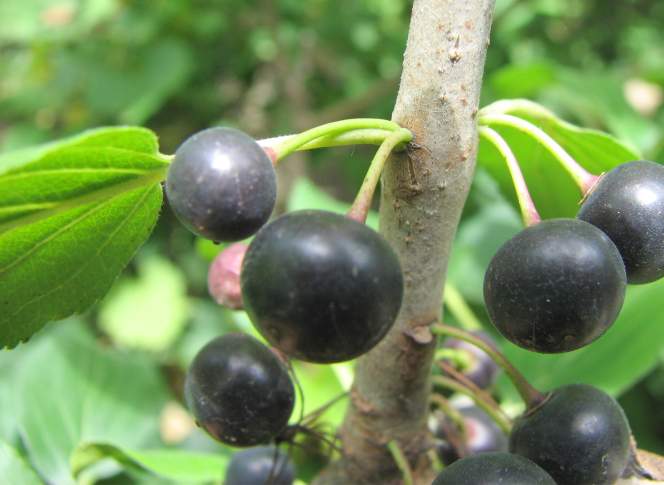How To Take Control Of Buckthorn
Property owners who are battling with the invasive buckthorn in their woods and are determined to take action should consider applying herbicide in the next few weeks.
October 11, 2016

Buckthorn with ripe berries

Property owners who are battling with the invasive buckthorn in their woods and are determined to take action should consider applying herbicide in the next few weeks.
In general, mid to late fall is the best time to treat buckthorn, when sap is flowing toward the roots, which allows for the most absorption of herbicide. In addition, this invasive species keeps its leaves and continues growing much later than other plants, minimizing the damage the herbicide will do to other species that have gone dormant for winter.
Introduced to the U.S. in 1849 as an ornamental plant, buckthorn has become widespread in many woodlands, prairies, abandoned fields, bogs, marshes and roadsides in several states. Common buckthorn (Rhamnus cathartica) and glossy buckthorn (Rhamnus frangula) are two common species in the Midwest that can quickly dominate the forest floor with their dense thickets of growth.
Both types can grow to more than 10 feet tall as a large shrub or small tree. Common, or European buckthorn, can grow as high as 25 feet and has an upright oval form, with dark green leaves that range dull to glossy. Glossy buckthorn (also known as smooth buckthorn and European alder) also has an oval, upright form and tops out at 18 feet. Its leaves are glossy and dark green.
Buckthorns create an impenetrable layer that displaces native plants on forest floor’s understory, or the underlying layer of vegetation, by shading out the trees and shrubs growing between the forest canopy and the forest floor. Ultimately, buckthorn causes long-term decline of forests by shading.
Buckthorns are fairly adaptable to full sun, shade and varying soil conditions. They leaf out early in spring and shed very late in fall to outcompete native plants for light, space and nutrients. Under full sun, buckthorn can reach maturity within a few years and can produce abundant berries that begin to ripen from August through September. Each berry contains three or four seeds that can remain viable in the soil for up to three years. The berries have a laxative effect on birds and mammals, causing a widespread distribution of the buckthorn seeds through their droppings.
Local University of Wisconsin-Extension offices can identify plant samples and determine whether they are buckthorn or another invasive species. The Wisconsin Department of Natural Resources also provides information.
The best approach to controlling buckthorn is to take preventive measures. Owners of adjacent properties should talk with each other so they understand that wildlife can easily spread seeds from one property to another. Another proactive method is to hand pull isolated seedlings less than half an inch in diameter, especially when the ground is moist.
However, once the buckthorn is well established, fall application of herbicide is recommended because large plants are hard to remove by hand and cut stumps readily resprout. A spray with 2 percent glyphosate (Roundup) or 1% triclopyr (Garlon) can be applied in late October after native plants have gone dormant. Product labels should be read and followed for safety and direction. Another application should be made in the spring or early summer in the next growing season to prevent next generation seedlings.
Buckthorn of less than 6 inches in stem diameter can be controlled by basal bark treatment technique. An oil formulated herbicide solution containing 6% triclopyr (Garlon 4, Pathfinder) as active ingredient is sprayed evenly around the stem to a height of about 12-15 inches above the ground.
Larger plants with a trunk diameter of 6 inches or more can be treated using the cut stump method in late fall. A handsaw should be used to cut off the plant at the base of the trunk. A concentrated herbicide containing 20 to 25 percent glyphosate can then be applied with a sponge paint brush on the freshly cut stump. Berries that have fallen on the ground should be raked and placed in a clear plastic bag labeled as “Invasive plants – Please landfill” for yard waste disposal. Any re-sprout branches should be cut off and a 2 percent glyphosate applied.
For large scale infestations, it is best to develop a realistic management plan that encompasses a multiyear approach to tackle all stages of buckthorn growth.
Vijai Pandian is a horticultural agent and educator for the University of Wisconsin-Extension Brown County. This article is adapted from an item originally published by the Green Bay Press Gazette.
 Passport
Passport











Follow Us